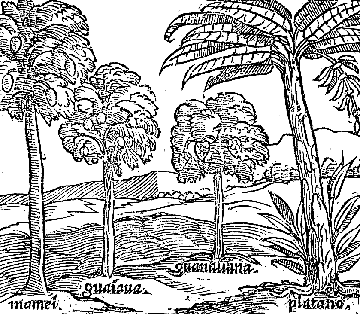Athena Review Image Archive ™
Fruit-bearing trees of Hispaniola

Fruit-bearing trees of Hispaniola (from Benzoni 1572).
In his Journal
for Nov. 4, 1492, Columbus describes the plants cultivated at río de
Mares in Hispaniola (the island now including the Dominican Republic
and Haiti): "...these lands are very fertile; they are full of mames
which are like carrots and have the flavor of chestnuts; and they have
beans and kidney beans very different from ours and much cotton, which
they do not sow... "
On December 5, 1492, when the Niña anchored
at Puerto Saint Nicholas in Hispaniola, Columbus was also impressed by
the country's fertility. In the harbor mouth there was "... a field of
trees of a thousand kinds, all laden with fruit... believed to be
spices and nutmegs... Opposite the harbor there was a beautiful fertile
plain and in the middle of it [a] river, and... in this neighborhood
there must be large centers of population..."
Fruit-bearing trees of Hispaniola shown in this 16th c. illustration from Benzoni include the mamey (Mammea americana), guava (Psidium guajaba), guanabana (Annona muricata), and the plantain or banana (Musa sp.), "platano" in Spanish.
Copyright © 1996-2019 Rust Family Foundation (All Rights Reserved).